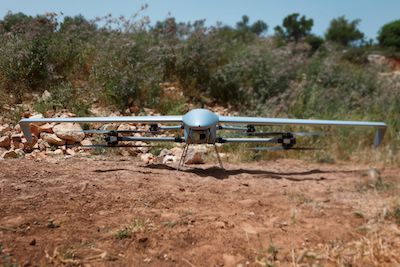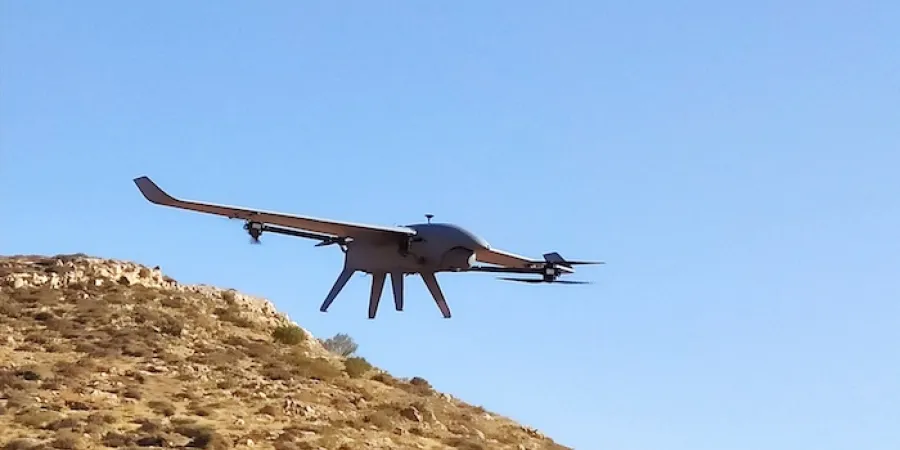Aeronautics introduces Trojan – a multi-sensor, multi-mission unmanned hover plane
The system's capabilities support challenging operational missions while simultaneously performing point-to-multipoint Intelligence, Surveillance and Reconnaissance (ISR), thereby creating a solution for versatile and dynamic environments, and achieving Wide-Area-Persistent-Surveillance
Eyal Boguslavsky
| 06/06/2022
Aeronautics Group, an Israeli provider of integrated holistic solutions based on unmanned aerial systems, payloads and communications for defense and HLS applications, is introducing the Trojan, an Unmanned Hover Plane (UHP), which bridges the gap between the need to hover and the need to reach long ranges.
According to Aeronautics, the system's capabilities support challenging operational missions while simultaneously performing point-to-multipoint Intelligence, Surveillance and Reconnaissance (ISR), thereby creating a solution for versatile and dynamic environments, and achieving Wide-Area-Persistent-Surveillance (WAPS). The system's multi-platform architecture utilizes multiple sensors, together with advanced analytics capabilities, to ensure accurate, reliable, real-time situational awareness.

The new UHP configuration gives Trojan long endurance - 2.5-hour flight time, long-range - up to 150 Km, and fast flight capabilities, combined with the capacity to carry multiple payloads up to 12 Kg in weight, all packed into a small tactical platform. The system enables execution of demanding, complex missions by tactical base stations, each of which control up to four platforms, simultaneously. Each platform, when facing a battle scenario, can channel and produce sensor data that can optimize the mission's performance.
Trojan has been designed to enable operations in harsh environments - characterized by adversary operations, day and night operational activity and extreme environmental conditions - while maintaining high efficacy within a small footprint.
The UHP’s Ground Control Station (GCS) is controlled via a user-friendly interface and can be safely operated by a single operator. Collecting field information, it supports mission planning and monitoring in all operational modes, and payload control.
The system's capabilities support challenging operational missions while simultaneously performing point-to-multipoint Intelligence, Surveillance and Reconnaissance (ISR), thereby creating a solution for versatile and dynamic environments, and achieving Wide-Area-Persistent-Surveillance
Aeronautics Group, an Israeli provider of integrated holistic solutions based on unmanned aerial systems, payloads and communications for defense and HLS applications, is introducing the Trojan, an Unmanned Hover Plane (UHP), which bridges the gap between the need to hover and the need to reach long ranges.
According to Aeronautics, the system's capabilities support challenging operational missions while simultaneously performing point-to-multipoint Intelligence, Surveillance and Reconnaissance (ISR), thereby creating a solution for versatile and dynamic environments, and achieving Wide-Area-Persistent-Surveillance (WAPS). The system's multi-platform architecture utilizes multiple sensors, together with advanced analytics capabilities, to ensure accurate, reliable, real-time situational awareness.

The new UHP configuration gives Trojan long endurance - 2.5-hour flight time, long-range - up to 150 Km, and fast flight capabilities, combined with the capacity to carry multiple payloads up to 12 Kg in weight, all packed into a small tactical platform. The system enables execution of demanding, complex missions by tactical base stations, each of which control up to four platforms, simultaneously. Each platform, when facing a battle scenario, can channel and produce sensor data that can optimize the mission's performance.
Trojan has been designed to enable operations in harsh environments - characterized by adversary operations, day and night operational activity and extreme environmental conditions - while maintaining high efficacy within a small footprint.
The UHP’s Ground Control Station (GCS) is controlled via a user-friendly interface and can be safely operated by a single operator. Collecting field information, it supports mission planning and monitoring in all operational modes, and payload control.



